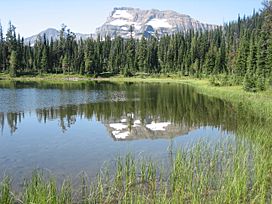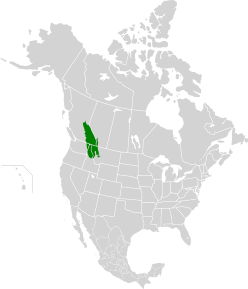North Central Rockies forests facts for kids
Quick facts for kids North Central Rockies forests |
|
|---|---|

|
|
 |
|
| Ecology | |
| Realm | Nearctic |
| Biome | Temperate coniferous forests |
| Borders |
List
|
| Bird species | 219 |
| Mammal species | 79 |
| Geography | |
| Area | 245,700 km2 (94,900 sq mi) |
| Countries | United States and Canada |
| States/Provinces | Idaho, Montana, Washington, British Columbia and Alberta |
| Rivers | Columbia River |
| Conservation | |
| Conservation status | Vulnerable |
| Habitat loss | 2.1976% |
| Protected | 39.72% |
The North Central Rockies forests is a special kind of forest found in parts of Canada and the United States. It's known as a temperate coniferous forest, which means it has lots of cone-bearing trees like pines and firs, and the weather is not too hot or too cold. This area gets more rain than the forests to its south. It is also unique because it has many plant and animal species that usually live near the Pacific Ocean.
Contents
Where Are the North Central Rockies Forests?
This amazing forest region is located in the Rocky Mountains. You can find it in southeastern British Columbia and southwestern Alberta in Canada. In the United States, it stretches across northwestern Montana, northern Idaho, and northeastern Washington.
Climate and Weather in the Rockies
The weather here changes a lot depending on where you are. West of the Continental Divide, it rains more. The Pacific Ocean also makes the weather milder there. East of the Divide, the climate is drier and more extreme.
In the Canadian part of this region, the average yearly temperature is about 3.5°C (38.3°F) in the east. It gets warmer, up to 5.5°C (41.9°F), in the west. Summers are warm, around 12.5°C (54.5°F) to 14.5°C (58.1°F). Winters are cold, from -3.5°C (25.7°F) to -6.5°C (20.3°F).
Rain and Snow in the Valleys and Mountains
Valleys in this region have warm, wet summers. Their winters are mildly cold and snowy. Higher up in the mountains, called the subalpine zone, summers are cool and can even have frost. Winters there are very cold and snowy.
The amount of rain and snow varies. Valleys usually get between 500 mm (20 in) and 800 mm (31 in) each year. High mountain areas can get over 1000 mm (39 in) of precipitation.
Plants and Trees of the North Central Rockies
This ecoregion is mostly covered by coniferous forests. These forests are full of trees that have needles and cones.
Lower Elevation Forests
In the lower parts of the mountains, you'll find many Western hemlock (Tsuga heterophylla) and Western red cedar (Thuja plicata) trees. Subalpine fir (Abies lasiocarpa) is also common. You might also see smaller groups of Lodgepole pine (Pinus contorta) and Douglas-fir (Pseudotsuga menziesii). Western white pine (Pinus monticola) and Western larch (Larix occidentalis) grow here too.
High Mountain Forests
Higher up, in the subalpine zones, the main trees are Engelmann spruce (Picea engelmanni) and Subalpine fir (Abies lasiocarpa). If there has been a fire, Lodgepole pine (Pinus contorta) often grows back first.
Other Plant Areas
Besides the dense forests, this region also has other types of plant communities. There are open meadows, grassy areas at the base of the mountains, and woodlands along rivers. At the very highest elevations, near the tree line, you can find alpine zone plants that are used to cold, harsh conditions.
Animals of the North Central Rockies
The North Central Rockies forests are home to many different mammals. Here are some of the animals you might find:
- Gray wolf (Canis lupus)
- Grizzly bear (Ursus arctos horriblus)
- Wolverine (Gulo gulo)
- Woodland caribou (Rangifer tarandus caribou)
- Black bear (Ursus americanus cinnamomum)
- Mountain goat (Oreamnos americanus)
- Mule deer (Odocoileus hemonius)
- White-tailed deer (Odocoileus virginianus)
- Rocky Mountain elk ( Cervus canadensis nelson)
- Moose (Alces alces)
- Coyote (Canis latrans)
- Cougar (Puma concolor)
- Bobcat (Lynx rufus)
- Fisher (Martes pennanti)
- American marten (Martes americana)
Protecting the North Central Rockies Forests
Even though large parts of this forest are still healthy and protected, its overall health is listed as "vulnerable." This means it could be at risk in the future.
Threats to the Forest
The main dangers to this ecoregion include:
- Resource extraction and development: Taking out natural resources like timber or minerals.
- Increasing human activity: More people visiting or living in the area.
- Logging: Cutting down trees for wood.
- Mining: Digging for valuable minerals.
- Livestock grazing: Animals like cows eating plants in the forest.
- Introduction of exotic species: New plants or animals that are not native to the area. These can sometimes harm the local ecosystem.
Special Protected Areas
Thankfully, many parts of this ecoregion are protected. These special areas help keep the forests safe for future generations. Some of these protected places include:
- Glacier National Park in northwestern Montana, USA.
- Yoho National Park and Kootenay National Park in southeastern British Columbia, Canada.
- Waterton Lakes National Park in far southwestern Alberta, Canada.
- The Selway-Bitterroot Wilderness in northeastern Idaho, USA.

